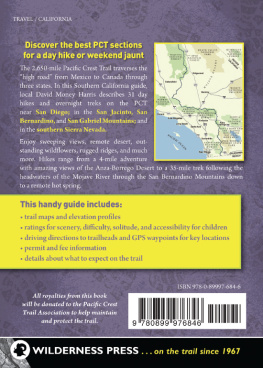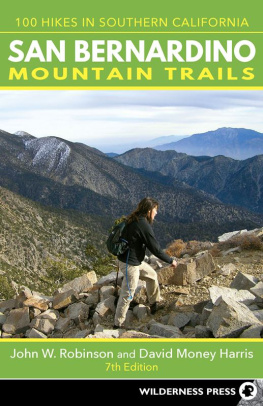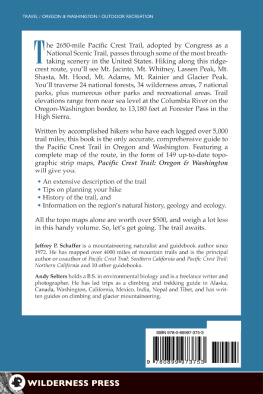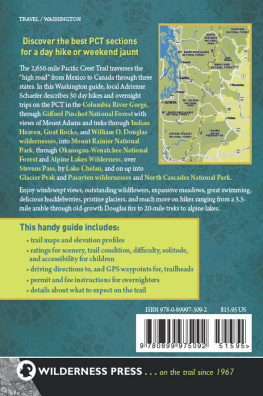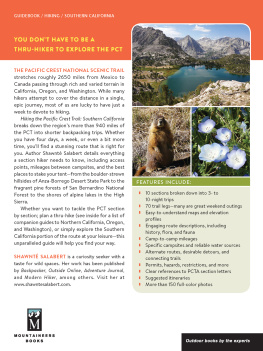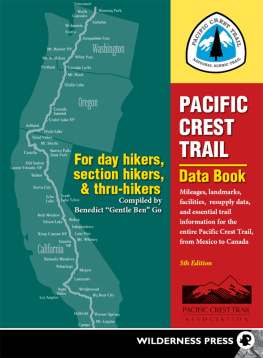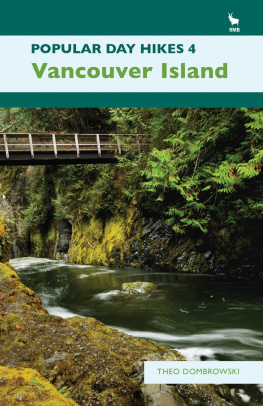


Map Key
Trail Name
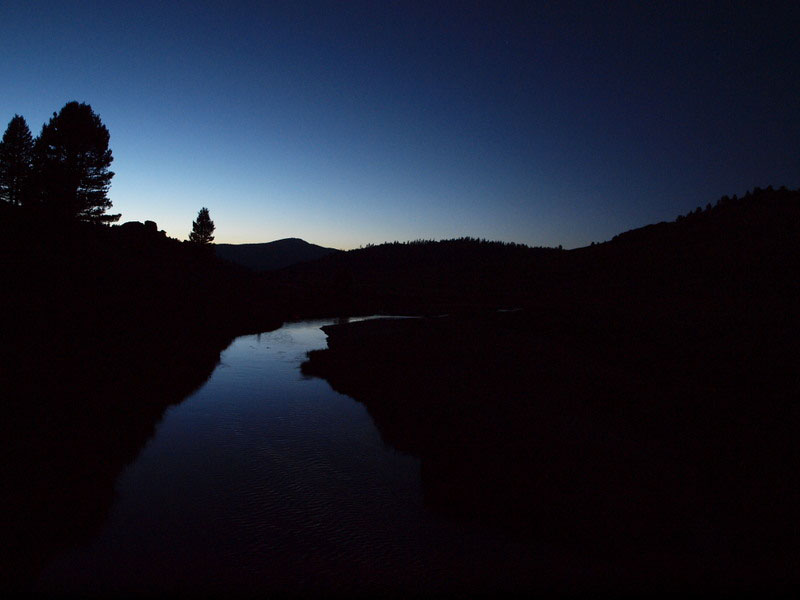
Day & Section Hikes Pacific Crest Trail: Southern California
1st EDITION 2012
Copyright 2012 by David Money Harris
Front cover photos copyright 2012 by the author
Interior photos, except where noted, by the author
Maps: David Money Harris and Scott McGrew
Cover design: Scott McGrew
Book design and layout: Ian Szymkowiak/Palace Press International
Editor: Laura Shauger
ISBN 978-0-89997-684-6
Manufactured in the United States of America
| Published by: | Wilderness Press |
| Keen Communications |
| PO Box 43673 |
| Birmingham, AL 35243 |
| (800) 443-7227 |
| info@wildernesspress.com |
| www.wildernesspress.com |
Visit our website for a complete listing of our books and for ordering information.
Distributed by Publishers Group West
Cover photos: Main: Delamar Mountain with Big Bear Lake and San Gorgonio Mountain in the distance ().
Frontispiece: Twilight on the Kern River ()
All rights reserved. No part of this book may be reproduced in any form, or by any means electronic, mechanical, recording, or otherwise, without written permission from the publisher, except for brief quotations used in reviews.
SAFETY NOTICE: Although Wilderness Press and the author have made every attempt to ensure that the information in this book is accurate at press time, they are not responsible for any loss, damage, injury, or inconvenience that may occur to anyone while using this book. You are responsible for your own safety and health while in the wilderness. The fact that a trail is described in this book does not mean that it will be safe for you. Be aware that trail conditions can change from day to day. Always check local conditions, know your own limitations, and consult a map.
Dedication
T O J ENNIFER , B ENJAMIN , S AMUEL , AND A BRAHAM
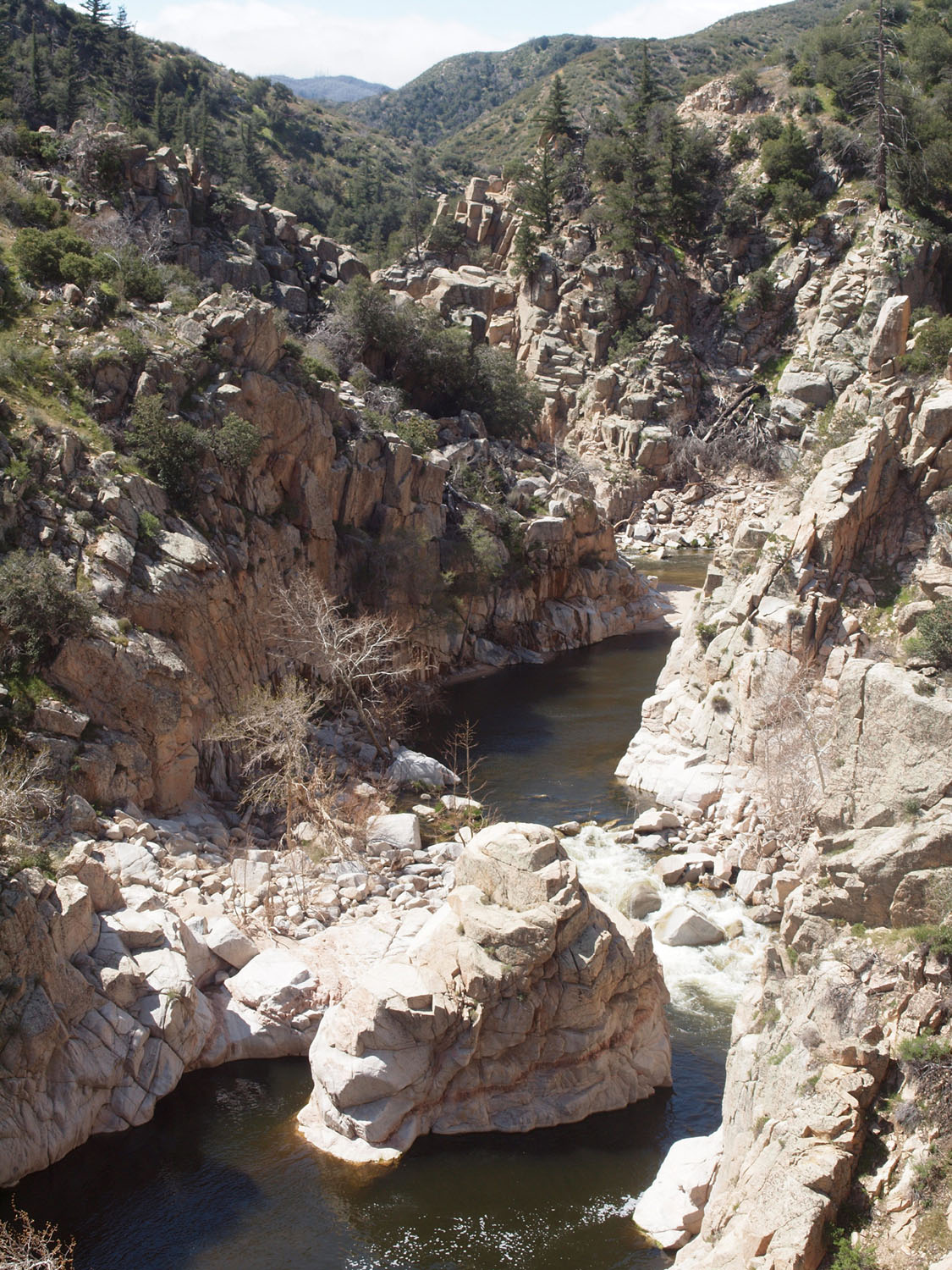
Deep Creek ()
Preface
W ELCOME TO THE P ACIFIC C REST T RAIL ! One of Americas National Scenic Trails, the PCT runs 2,650 miles from Mexico to Canada along the mountainous backbone of California, Oregon, and Washington. This trail boasts the greatest elevation change and the most diverse scenery of any of the National Scenic Trails.
Each year, roughly 500 thru-hikers venture forth with the intent of hiking the entire PCT, leaving behind jobs and loved ones for the five-month journey. Several excellent books, including the three-volume Pacific Crest Trail series from Wilderness Press, help these hardy folks find their way.
But every year, tens of thousands of other hikers set foot on the PCT to hike for an hour, a day, or a weekend. This guide is part of a four-volume series written for day and section hikers seeking a casual excursion or moderate backpacking trip on one of our nations most famous trails.
Even when I am hiking for just a few hours on the PCT, the question What if I kept going? invariably springs to mind. The romance of thru-hiking is unquestionably part of the allure of the trail. But I have young children and responsibilities at work, and this is not yet the right time in my life to be out for an extended journey. Most of us have similar constraints and can only spare a day or two or perhaps a long weekend at a time to answer the call of the wild. Thankfully, the PCT has dozens of segments offering hiking as fine as anywhere else in Southern California. This book features many of the best trips along the PCT between the Mexican border and the High Sierra. I have personally walked every trip in this book carrying a GPS receiver to log the trail. I have also walked a few segments that were not so satisfying and which I did not cover in this book.
The Pacific Crest Trail was first envisioned in the 1930s by Clinton Clarke, who pictured it as traversing the best scenic areas and maintaining an absolute wilderness character. Clark founded the Pacific Crest Trail Conference, with members including the Boy Scouts, YMCA, and Ansel Adams, to plan and advocate for the trail. More than 40 YMCA groups spent the summers of 1935 to 1938 planning and exploring the route from Mexico to Canada. Todays trail largely follows the path pioneered by these young trailblazers. In 1968, Congress passed the National Trail Systems Act that established the Appalachian Trail and PCT as the first National Scenic Trails, extended trails so located as to provide for maximum outdoor recreation potential and for the conservation and enjoyment of nationally significant scenic, historic, natural, or cultural qualities. A bold 18-year-old adventurer was the first to hike the entire contiguous distance, and his travel yarn, The High Adventures of Eric Ryback , tells a romantic story of his 1970 journey. In 1976, Teddi Boston, a 49-year-old mother of four, became the first woman to hike the entire distance solo. However, despite these groundbreaking trips, tremendous work remained to secure a right-of-way and construct nearly a thousand miles of trail. The trail was declared officially complete in 1993, but work continues even today to improve and protect it.
The Pacific Crest Trail Conference evolved into the Pacific Crest Trail Association (PCTA) in 1992. Today, the PCTA is a nonprofit organization that stewards the trail under a memorandum of understanding with the U.S. Forest Service, National Park Service, and Bureau of Land Management. The PCTA protects, preserves, and promotes the trail. Some of their key activities include trail maintenance, protecting the trail from urban encroachment and the scars of resource extraction, and sharing trail information. The staff at the PCTA was tremendously helpful while I was researching this guide. The royalties from this book will be donated to the PCTA to care for the trail. If you enjoy hiking on the PCT, you may find volunteering on a trail crew deeply satisfying. For more information, see www.pcta.org.
Several individuals have contributed ideas or reviews that have improved this book. They include Tony Condon, Sally Harris, Anitra Kass, Joe Sheehy, Elizabeth Thomas, and Fritz Ward. Also, numerous students from the Claremont Colleges On the Loose outdoor club have joined me scouting the trails.
I am indebted to my editors, Roslyn Bullas, Molly Merkle, and Laura Shauger for envisioning this series, inviting me to write this book, and helping bring the guide to completion. Designer Scott McGrew transformed the GPS data I gathered into useful maps. Annie Long did a terrific job with the page layout.
This book could not have happened without the support of my wife Jennifer. She and our young sons joined me for several of the shorter trips, and she was patient and encouraging as I spent numerous weekends away doing fieldwork for the longer trips.

Agua Caliente Creek ()
Recommended Hikes
M OST S CENIC
B EST FOR W ILDFLOWERS
Next page
